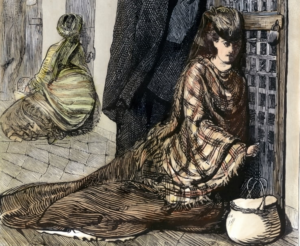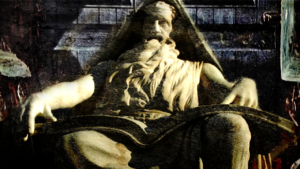Consciousness is A Stream

In 2002, Jason Padgett, a bodybuilder, was brutally assaulted at a nightclub. After the incident, something remarkable happened to his brain. Padgett suddenly developed a talent for abstract geometrical draughtsmanship. What can his story tell us about consciousness?
Before Padgett’s injury, he had no interest or aptitude for geometry or mathematics. What was the cause of his sudden obsession with shapes? Doctors discovered that he sustained bilateral damage to his brain, but the injuries were more severe in his right hemisphere. The damage done to his right hemisphere forced his left hemisphere into compensating by going into overdrive This part of the brain, as Iain McGilChrist writes, “prefers narrow focus, rule-following, and is engaged by parts or fragments.”
Everything in Padgett’s world, from trees to clouds to water, started to develop an explicit, abstract structure. Living, embodied forms suddenly became something new and beautiful, but essentially numerical and inanimate, ‘like an equation translating’, as he said.
“I thought there was more to the nature of the universe than equations—I thought perhaps the universe spoke in its own form of math. And that math was geometry. Equations were symbolic; numbers were symbolic. But to me, geometry was real.” Padgett saw shapes and angles everywhere in nature, ‘from the geometry of a rainbow to the fractals in water spiraling down a drain.’ He drew a picture of water spiraling down a drain, entitled ‘black hole’, showcasing the pattern of lines he saw overlaid on the water.
Padgett’s injury might lead one to believe that the brain is the seat of consciousness since his damaged right hemisphere changed his behavior, but what if there’s another explanation for this? What if the brain, or matter, limits consciousness, instead of producing it? Friedrich Schiller once said that if something happens to a person’s brain, “the man after a time more or less recovers the faculties of which the injury to his brain had deprived him, and that not in consequence of a renewal of the injured part, but in consequence of the inhibited functions being performed by the vicarious action of other parts, the easiest explanation certainly is that after a time consciousness constitutes the remaining parts into a mechanism capable of acting as a substitute for the lost parts.” In other words, in the case of a brain injury, the mechanism of consciousness is thrown out of gear, so that its properly limiting function is deficient, and certain aspects of thinking are no longer capable of being shaped into being, as was the case with Padgett.
As Iain McGilchrist writes, when the brain is functioning correctly, “it shuts out from the field of our consciousness all that is of no practical interest to us, all that does not lend itself to our action.”
It is the brain that is in the mind, not the mind in the brain.
Some scientific findings confirm the filter hypothesis of the brain. Suppression of the left medial frontal cortex, for example, has been found to increase a subject’s ability to influence the numerical output of a random event generator. Most compellingly, during near-death experiences, EEG scans show brain activity to be absent. During these experiences, patients report feeling an overwhelming sense of peace and well-being, a sense of cosmic unity, and being one with everything.
Why don’t we have these experiences? Why can’t we see the hidden harmonies in nature like Padgett? The brain has to formulate conceptual structures that are much simpler than the complex phenomena they are attempting to account for, in order to interact properly with the world. In an industrial society, the left hemisphere – the analytical part of the brain – must tie down the stream of happening into the unity of ego, to dictate its ‘law’ to the content of the world, in order to understand and engage with it. A man living in a city will perceive nature differently from a man who lives out in the wild, just as an anatomist will look at a corpse differently from us.
We are transmitters, not originators, of consciousness. The brain’s relationship to the world is analogous to M.C. Escher’s painting of two hands drawing each other. In one study, it was found that: “subjects had one or other hemisphere suppressed, and those with their left hemisphere suppressed were ‘like young children or representatives of archaic societies.”
What can Padgett’s story tell us about consciousness? James saw the entire universe as a seamless flow, “its members interdigitate with their next neighbors in manifold directions, and there are no clean cuts between them anywhere.”
Thus matter + energy are connected at every level.
Consciousness is like a stream. The human organism is not a machine, but a stable metabolic flow of energy and matter. As the German poet Novalis observed, “there is no doubt that our body is a molded river.” Just as the banks of a river constrain the flow of water and are integral to its being a river, all experience comes to us through the brain and is therefore constrained and shaped by it, like air passing through vocal cords giving rise to your personal voice.











